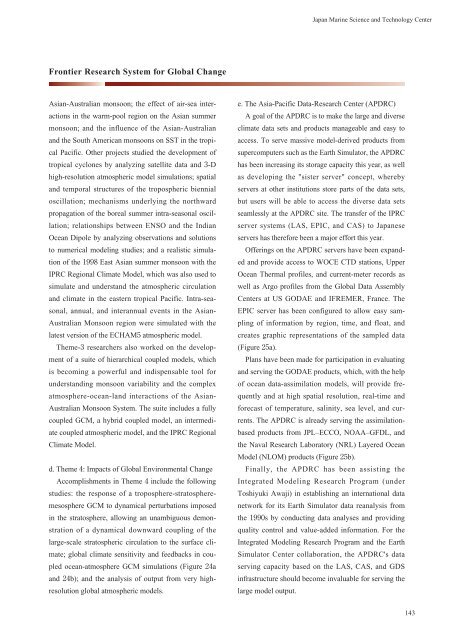Marine Ecosystems Research Department - jamstec japan agency ...
Marine Ecosystems Research Department - jamstec japan agency ...
Marine Ecosystems Research Department - jamstec japan agency ...
Create successful ePaper yourself
Turn your PDF publications into a flip-book with our unique Google optimized e-Paper software.
Japan <strong>Marine</strong> Science and Technology Center<br />
Frontier <strong>Research</strong> System for Global Change<br />
Asian-Australian monsoon; the effect of air-sea interactions<br />
in the warm-pool region on the Asian summer<br />
monsoon; and the influence of the Asian-Australian<br />
and the South American monsoons on SST in the tropical<br />
Pacific. Other projects studied the development of<br />
tropical cyclones by analyzing satellite data and -D<br />
high-resolution atmospheric model simulations; spatial<br />
and temporal structures of the tropospheric biennial<br />
oscillation; mechanisms underlying the northward<br />
propagation of the boreal summer intra-seasonal oscillation;<br />
relationships between ENSO and the Indian<br />
Ocean Dipole by analyzing observations and solutions<br />
to numerical modeling studies; and a realistic simulation<br />
of the East Asian summer monsoon with the<br />
IPRC Regional Climate Model, which was also used to<br />
simulate and understand the atmospheric circulation<br />
and climate in the eastern tropical Pacific. Intra-seasonal,<br />
annual, and interannual events in the Asian-<br />
Australian Monsoon region were simulated with the<br />
latest version of the ECHAM atmospheric model.<br />
Theme- researchers also worked on the development<br />
of a suite of hierarchical coupled models, which<br />
is becoming a powerful and indispensable tool for<br />
understanding monsoon variability and the complex<br />
atmosphere-ocean-land interactions of the Asian-<br />
Australian Monsoon System. The suite includes a fully<br />
coupled GCM, a hybrid coupled model, an intermediate<br />
coupled atmospheric model, and the IPRC Regional<br />
Climate Model.<br />
d. Theme : Impacts of Global Environmental Change<br />
Accomplishments in Theme include the following<br />
studies: the response of a troposphere-stratospheremesosphere<br />
GCM to dynamical perturbations imposed<br />
in the stratosphere, allowing an unambiguous demonstration<br />
of a dynamical downward coupling of the<br />
large-scale stratospheric circulation to the surface climate;<br />
global climate sensitivity and feedbacks in coupled<br />
ocean-atmosphere GCM simulations (Figure a<br />
and b); and the analysis of output from very highresolution<br />
global atmospheric models.<br />
e. The Asia-Pacific Data-<strong>Research</strong> Center (APDRC)<br />
A goal of the APDRC is to make the large and diverse<br />
climate data sets and products manageable and easy to<br />
access. To serve massive model-derived products from<br />
supercomputers such as the Earth Simulator, the APDRC<br />
has been increasing its storage capacity this year, as well<br />
as developing the "sister server" concept, whereby<br />
servers at other institutions store parts of the data sets,<br />
but users will be able to access the diverse data sets<br />
seamlessly at the APDRC site. The transfer of the IPRC<br />
server systems (LAS, EPIC, and CAS) to Japanese<br />
servers has therefore been a major effort this year.<br />
Offerings on the APDRC servers have been expanded<br />
and provide access to WOCE CTD stations, Upper<br />
Ocean Thermal profiles, and current-meter records as<br />
well as Argo profiles from the Global Data Assembly<br />
Centers at US GODAE and IFREMER, France. The<br />
EPIC server has been configured to allow easy sampling<br />
of information by region, time, and float, and<br />
creates graphic representations of the sampled data<br />
(Figure a).<br />
Plans have been made for participation in evaluating<br />
and serving the GODAE products, which, with the help<br />
of ocean data-assimilation models, will provide frequently<br />
and at high spatial resolution, real-time and<br />
forecast of temperature, salinity, sea level, and currents.<br />
The APDRC is already serving the assimilationbased<br />
products from JPL–ECCO, NOAA–GFDL, and<br />
the Naval <strong>Research</strong> Laboratory (NRL) Layered Ocean<br />
Model (NLOM) products (Figure b).<br />
Finally, the APDRC has been assisting the<br />
Integrated Modeling <strong>Research</strong> Program (under<br />
Toshiyuki Awaji) in establishing an international data<br />
network for its Earth Simulator data reanalysis from<br />
the s by conducting data analyses and providing<br />
quality control and value-added information. For the<br />
Integrated Modeling <strong>Research</strong> Program and the Earth<br />
Simulator Center collaboration, the APDRC's data<br />
serving capacity based on the LAS, CAS, and GDS<br />
infrastructure should become invaluable for serving the<br />
large model output.<br />
143
















